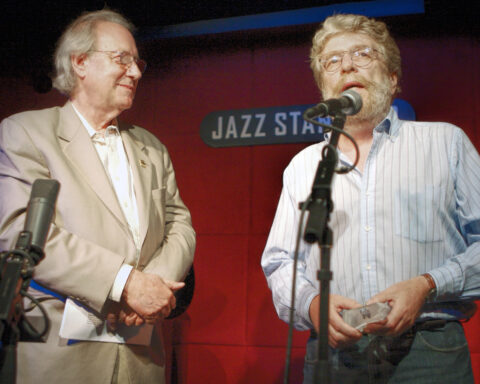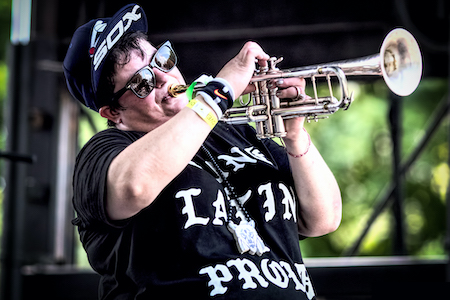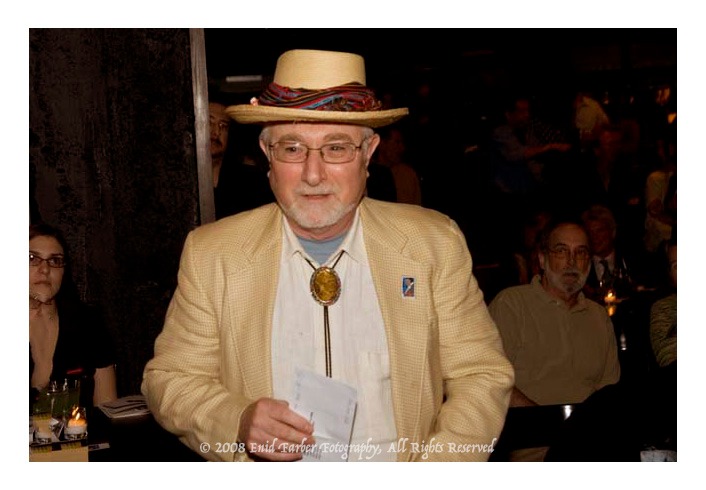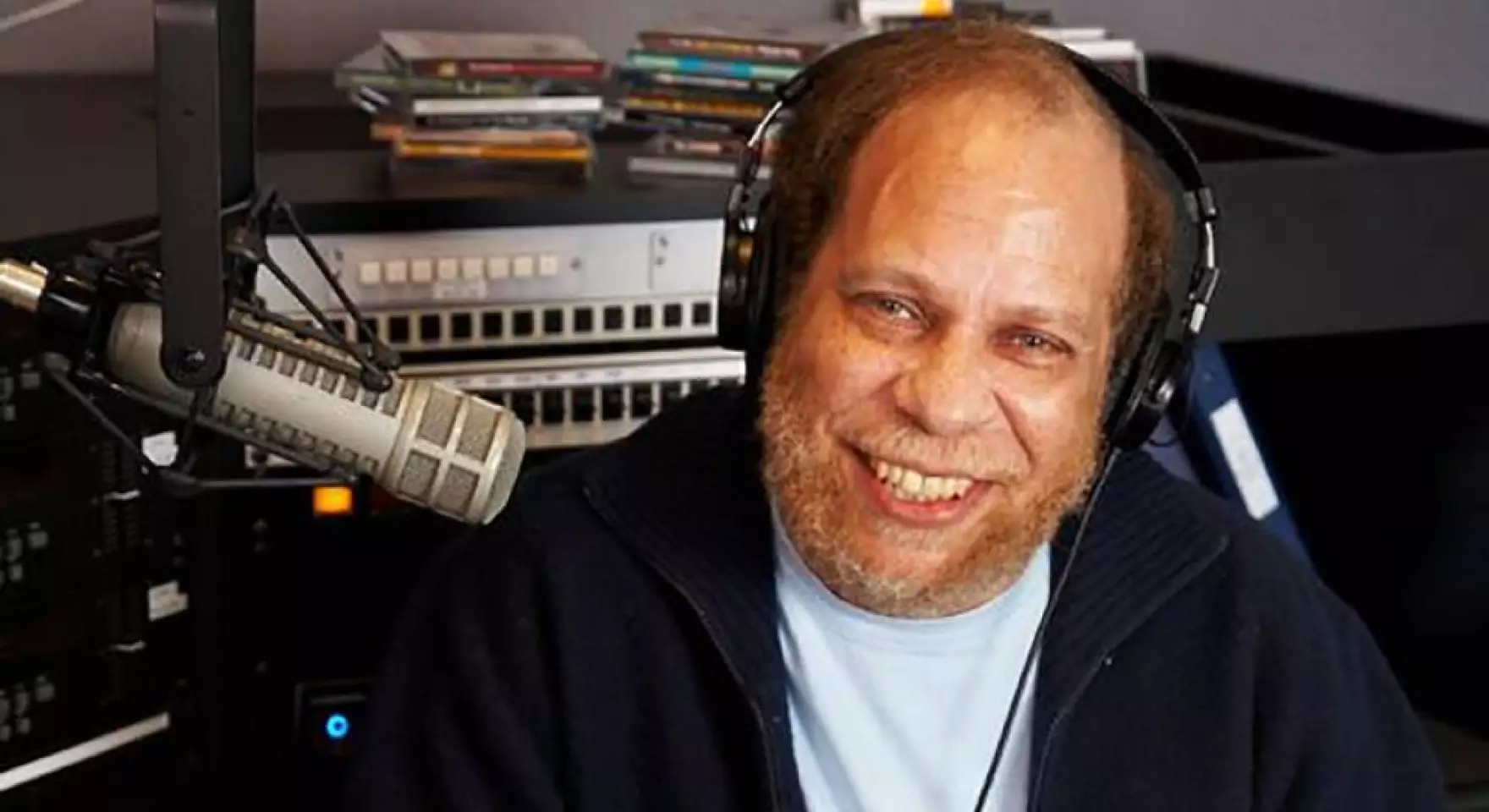
Veteran jazz journalist Lee Jeske, who covered the scene from his New York City base starting in the late 1970s, passed away on April 8, 2018 at the age of 62. A Queens native who resided in Manhattan’s East Village, Jeske was the East Coast editor of DownBeat during the late 1970s, New York editorial bureau chief of Cash Box from the late ’80s to early ’90s and a freelance contributor to the New York Post during the late ’80s. He was an early member of the Jazz Journalists Association, and friend to many of his generation’s most active writers, photographers and broadcasters.
He also wrote a monthly column in the late ‘90s for the website CitySearch called “Jazzbeat,” a compendium for his witty and sometimes snarky observations about the scene he covered. That first-person column in particular caused some fellow scribes to regard Jeske as “the Andy Rooney of jazz,” a reference to the wry, sometimes curmudgeonly essayist who appeared weekly on CBS’s “60 Minutes.”
A jovial, outgoing figure, Jeske loved to laugh and often strived to insert humorous asides into his pieces to share a laugh with his readers. His style was casual and conversational, often with a first-person stream-of-consciousness flair. Take, for example, this patented Jeske intro to his Pepper Adams feature in the August 1982 issue of DownBeat:
I’m not sure why I watch the Grammy Awards every year. I rarely like the music they present, and I usually spend most of the endless three hours just clucking my tongue at the lack of any real presentation of jazz on the show. Oh sure, there is always a token jazz performance, but it is usually by an established icon – Basie, Fitzgerald – or a jazz/pop star – Mangione, Jarreau. It usually receives a large, gratuitous ovation and has as much to do with the real state of the music as Luciano Pavarotti singing Sorrento or Placido Domingo duetting with a porky puppet has to do with the current state of classical music.
I checked the TV Guide in advance: it was going to be Jarreau. So I slumped down in the chair, flicked on the show and sat bolt upright as the alphabetical guest list began. Was that Pepper Adams’ name I heard? Pepper Adams – the skinny, rumpled, owlish master of the baritone sax – was on the Grammy Awards?
Here’s Jeske in prime form in an April 2, 1998 “Jazzbeat” column from CitySearch:
This is a true story: About seven or eight years ago I was at the Village Vanguard and Wynton Marsalis, who was not performing that night, was there as well. We both left about the same time and, chatting on the way out the door, decided to share a cab up to the Upper West Side where we both lived. After a stroll to Sheridan Square to pickup the newspapers, Wynton grinned and said, “Let me get the cab.” He stepped into the street, stuck out his arm and we watched cab after cab zip by him — a young, casually dressed black man on the streets of New York. He was laughing, of course, but his point was made and eventually I took over, easily hailed us a taxi, and home we went. “If you ever need a cab,” I joked, “call me.”
Jeske may have been the person for whom the term ‘wag’ was coined. His prose and private conversations always dripped with sarcasm and quick-witted putdowns. Check out this classic Jeske-ism: “The best thing I can say about Bob James is the guy had two names.” Or his take on the Knitting Factory’s first New York Jazz Awards show (in which the Jazz Journalists Association was involved), a historic event held at Alice Tully Hall that

drew an all-star crowd including such legends as Horace Silver, Roy Haynes, Elvin Jones, Charlie Haden and Milt Jackson: “Don Byron expressed the sentiments of everybody in the room when he said that he was ‘humbled’ by the evening. Don Byron and ‘humble’ are not usually used in the same sentence.”
Jeske loved puns and once joked that he was going to be producing a session for a Turkish oud player who played bebop on that lute-like stringed instrument. “We’re going to call the album Oud Bop Sh’Bam,” he proclaimed with a straight face. And though he made a career writing about jazz, he was equally passionate about New Orleans brass bands, zydeco music (he was a huge fan of Boozoo Chavis) and Fats Domino. He toured Europe covering jazz festivals but always made the annual pilgrimage down to the Crescent City at the end of April with his longtime partner Wendi Royal for the New Orleans Jazz & Heritage Festival. They would invariably attend the first weekend of Jazzfest then rent a car and drive to Lafayette to catch a few days of the Festival International de Louisiana before returning to New Orleans for the second weekend of Jazzfest. Few jazz critics loved to dance as much as Jeske did.
A lifelong fan of his beloved New York Yankees, Jeske proudly displayed the two seats he had procured from the original House That Ruth Built in the foyer of his East Village apartment. He was also a devout foodie and took great pleasure in sampling cuisine in secret places throughout the five boroughs as well as abroad, as he and Wendi investigated a world of exotic tastes in their travels to Brazil, China, Europe and places beyond. There was no more ardent fan of brisket, ribs and all things meat than Jeske, who was a regular at colleague Don Palmer’s annual Memorial Day barbecue parties at his Fort Greene, Brooklyn home. JJA President Howard Mandel fondly recalls a dinner he and Jeske shared as guests of then-editor of Jazziz, Larry Blumenfeld, at an all-you-can-eat Brazilian churrascaria.
Jeske’s first big break in jazz journalism came in 1977, when the 22-year-old aspiring scribe scored an interview for DownBeat with famously contentious bassist, composer and bandleader Charles Mingus, who was suffering from amyotrophic lateral sclerosis. Shortly after, Lee was invited to attend President Jimmy Carter’s June 18, 1978 Jazz on the White House Lawn concert, which he covered for the UK’s Jazz Journal International magazine.
During his tenure as DownBeat’s East Coast Editor, Jeske interviewed Bill Evans, Stan Getz, John McLaughlin, Stephane Grappelli, Scott Hamilton and many others. He wrote 93 sets of liner notes throughout his career, including releases by David Murray, Andrew Hill, George Adams/Don Pullen Quartet and Julius Hemphill, the brilliant Etudes by Charlie Haden, Paul Motian and Geri Allen, and the Cecil Taylor/Max Roach Historic Concerts from Columbia University in 1979 (all on the Italian Black Saint/Soul Note labels). He also annotated reissues for the Columbia/Legacy label (John McLaughlin’s Inner Worlds, Weather Report’s I Sing The Body Electric, Thelonious Monk’s Solo Monk, Miles Davis’ Agharta).
On October 16, 2001, Jeske participated in a panel discussion at The New School with pianist-composer Vijay Iyer and Columbia University professor Farrah Jasmine Griffin exploring “Why Jazz Matters, How It Helps” in light of the 9/11 terrorist attack on New York City. I’m sure Jeske somehow worked his irreverent wit and humor into that rather solemn topic.





